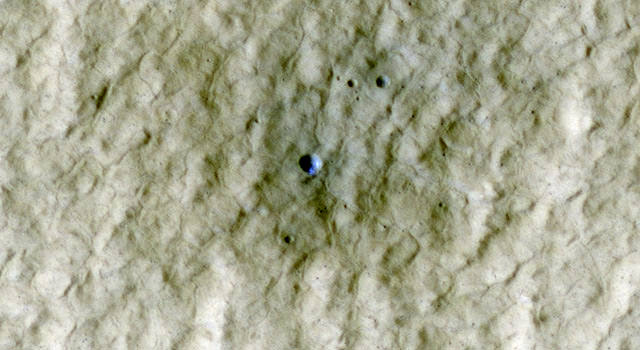[/caption]
Mars-o-philes rejoice! New images from Mars galore, including this “after” image of Mars’ northern hemisphere which reveals a new crater was created sometime between April 2004 and January 2010. Intriguingly, scientists believe exposed ice is visible in this new image from the HiRISE camera. This is just one of the latest release of hundreds of high-resolution HiRISE images, so go get your fill of Mars at the HiRISE site. But what about that ice?
The crater is at a latitude of 44 degrees North and is itself located on the ejecta of a larger crater. The image was acquired in early summer, when frost at this latitude is not expected. That’s why the HiRISE science team believes the bright blue material in this false-color color image is sub-surface ice that was exposed by the impact.
This ice is probably at the same depth and has a similar origin to that excavated by the Phoenix lander back in 2008. The area of exposed ice based on the HiRISE images is about 1-2 square meters (10-20 square feet.
An intriguing image, and a great example of the treasures available in this newest release of images from Mars.
For more images, see the HiRISE website.


I just want to say kudos to NASA, JPL-Caltech, and the University of Arizona for providing us with these splendid images from the planet Mars!
That’s not Mars, that’s my living room carpet. Needs a vacuum too.
Now this is the greatest news from Mars or Space in 25 years!
Finally!! But we can’t find life from here, we need to be there……
Evidence of a frozen ‘ocean’ under the dust of Mars continues to accumulate. Next up should be focusing on finding ‘hot spots’ where geothermal vents under the ice is creating liquid water?
I can’t help but wonder what Mars might have looked like during the same period as Earth’s last Ice Age?
@ Aqua,
The last Ice Age on the Earth ended about 8,000 years ago, which peaked at about 20,000 years ago, but Mars has been in its present Siderikan period since 3,500 million years ago, so Mars probably looked no different 20,000 years ago than it does today — apart from some additional impact craters.
@IVAN3MAN_AT_LARGE
Your ‘guess’ is as good as mine… but you might check out some of the following:
http://adsabs.harvard.edu/abs/2004LPI….35.1244N
http://rss.msnbc.msn.com/id/7209308/ns/technology_and_science-space/
http://news.brown.edu/pressreleases/2008/04/martian-glaciers
http://www.space.com/scienceastronomy/080424-mars-active-climate.html
FYI – Wikipedia is very informative, but does NOT contain all the information on this subject.
@ Aqua,
Thanks for the links to those articles, which I found interesting and informative; however, those articles only mention that ‘recent’ geological/glacial activity on Mars may have occurred in “localized areas” a few million years ago, so it’s no more significant than the localized flooding of the Earth’s Black Sea region after the end of the last Ice Age.
To quote Aristotle: “One swallow does not a summer make,…”
There were some pictures taken by the Mars Reconnaissance Orbiters cameras which showed fresh craters that were cut in the usual brownish martian surface. These craters showed fresh white ice on their bottom. As these craters were photographed a couple of months later, the ice was gone. It disappered in the thin and martian atmospere.
The photos of these craters indicate that there is a thick layer of ice close to the surface at the location of these craters. There is plenty of ice on Mars, even at places that are thought to be completely void of any water and ice.
I think there will be more of those icy craters coming into view with time.
@GBENDT
Yeah.. apparently dust covers fresh craters fairly rapidly on Mars, which is another indication of how active the Martian atmosphere actually is. Also noted here S/B how much dust has accumulated on the Mars rovers = lots!. When we eventually send a manned mission, no doubt dust will be a major problem.
Thankfully, the next rover (Curiosity) will not be solar powered and instead will use an RGT (Radioisotope thermoelectric generator).
http://en.wikipedia.org/wiki/Radioisotope_thermoelectric_generator
Yikes! Plutonium-238! No fear, no worries though… even if the mission has a catastrophic mishap at launch, the RGT is encased in a very sturdy and well tested housing. AND it will have a minimum lifetime of 14 years! GO Curiosity!
Oops… RTG… duh